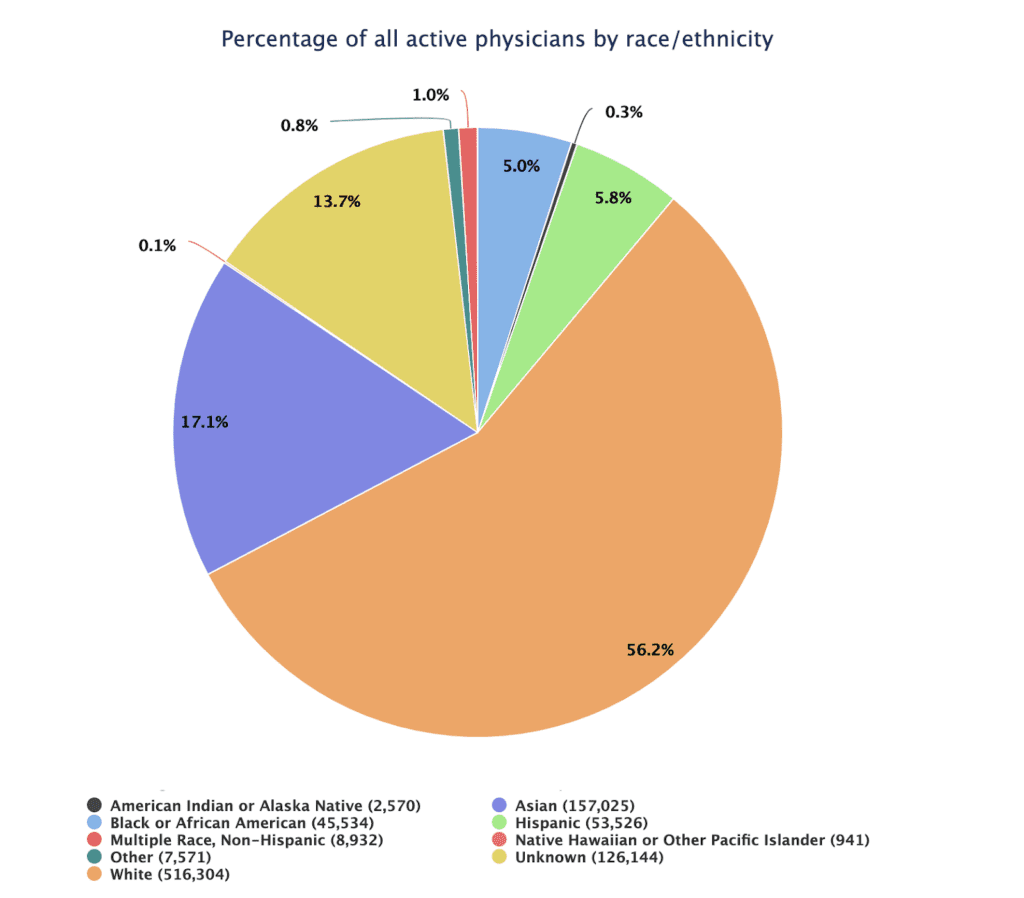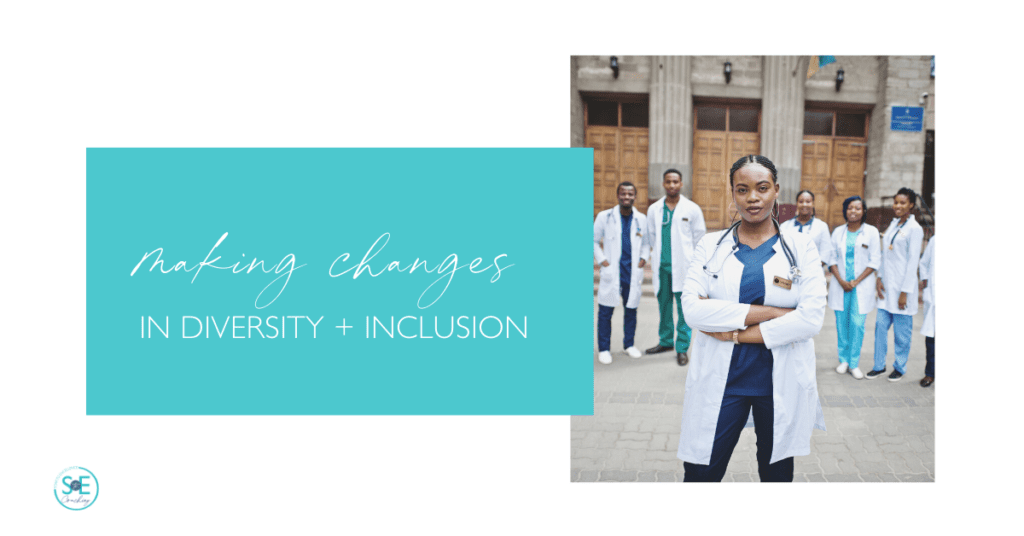
Cultivating Diversity in Medicine
Okay, a show of hands—How many of us are willing to put our lives in the hands of a doctor we don’t trust?
Any takers? Didn’t think so.
Our health is a big deal. It’s not something we can afford to gamble or drop the ball on. When choosing a primary care physician, we need an unbiased professional who makes us feel comfortable and understood. Underrepresented groups often struggle to find someone who meets this criteria.
As we slowly make strides towards diversity and inclusion, we must acknowledge healthcare as one of the many systems that set people of color up for failure.
Did you know that until the 1960s, women accounted for less than 10 percent of all doctors nationwide? If you think that’s bad, get this: Only 5 percent of doctors in America today are Black. That’s less than half the overall percentage of America’s Black population. Hispanic doctors are in short supply, too, only accounting for 5.8 percent of medical professionals.
According to statistics provided by the Association of American Medical Colleges, these are the percentages of all physicians by race/ethnicity in 2018:

Metropolitan areas are hit hardest by disparities in healthcare. About a third of New York state’s population is Black or Hispanic, but those groups only account for 12 percent of the doctors there.
The numbers are pretty dismal. And not just because people of color deserve to excel in every profession. Without proper representation in healthcare, we are disproportionately losing non-white lives.
THE DISPARITIES OF IMPLICIT BIAS
Implicit bias occurs when a person has internalized negative beliefs about people from certain groups. Many Americans, including physicians, are unaware of these biases and the ways in which they are harming underserved patients. Thus, implicit bias in healthcare can result in medical negligence towards disadvantaged populations.

Racial and Ethnic Populations.
In 2005, the National Academy of Medicine (NAM) conducted a study on the injustices that stem from the lack of diversity in the medical field. NAM found that “racial and ethnic minorities receive lower-quality health care than white people—even when insurance status, income, age, and severity of conditions are comparable.”
The American Bar Association reports, “One study of 400 hospitals in the United States showed that Black patients with heart disease received older, cheaper, and more conservative treatments than their white counterparts. After surgeries, they are discharged earlier from the hospital than white patients—at a stage when discharge is inappropriate.”
Additional studies by NAM reveal that people of color are less likely than their white counterparts to be given appropriate cardiac care, as well as adequate treatment for strokes, cancer, and AIDS.
That’s just the tip of the iceberg. Here are more statistics that may shock you:
- Black patients are 30 percent more likely to die from heart disease than their white counterparts and twice as likely to have a stroke.
- According to the CDC, Hispanic or Latinx persons are 2.3x more likely to die of COVID-19 than white individuals. American Indian or Alaska Natives are 2.4x more likely, while Black or African Americans are 1.9x more likely and Asians are 1.0x more likely to die.
- Another CDC report revealed that for women over the age of 30, the pregnancy-related mortality ratio for Black, American Indian, and Alaska Natives was 4-5x higher than for white women.
- Black women are 3-4x more likely to experience preventable pregnancy-related deaths than their white counterparts.
- The average waiting time for Black Americans needing kidney transplants is almost twice as long as that of white patients.
- In 2017, Hispanic mothers were 70 percent more likely to receive late or no prenatal care as compared to white mothers.
- Black women with breast cancer are 67 percent more likely to die from the disease than white women.
Black Maternal Health Week is observed annually from April 11th-17th to bring awareness and hopefully improve health outcomes for Black women. The American College of Obstetricians and Gynecologists (ACOG) notes that “continued efforts to improve the standardization of data and review processes related to U.S. maternal mortality are a necessary step to achieving the goal of eliminating disparities and preventable maternal mortality.” Without these foundations in place, the fatal effects disproportionately affecting Black women and other communities of color will continue.
The appalling disparities facing underserved individuals is not something to be taken lightly. These numbers reveal why people of color are reluctant to trust the healthcare system. As a result, they are less inclined to visit the doctor more regularly than their white counterparts. This further contributes to the demise of their overall health.

Members of the LGBTQ+ Community.
The LGBTQ+ community is another group that is prone to receiving subpar medical care. The medical field is predominantly Christian, which can result in religious biases that cause doctors to discriminate against their LGBTQ+ patients. Transgender people have an especially hard time finding physicians who understand their needs.
The National Gay and Lesbian Task Force and the National Center for Transgender Equality recently surveyed 6,450 transgender and gender non-conforming (GNC) people. This sample revealed that nearly 56 percent of LGBTQ+ individuals have experienced discrimination in some form while seeking medical care.
The statistics don’t stop there. The survey also showed that:
- 1 in 5 (~19 percent) trans people have been denied healthcare
- 50 percent have had to educate healthcare staff on their medical necessities, exposing a lack of competency or knowledge regarding appropriate care
- 28 percent of respondents postponed medical care when sick or injured for fear of discrimination and disrespect
- 28 percent have experienced harassment in a medical setting
- 41 percent reported attempting suicide, a staggering contrast compared to the 1.6 percent of the general population
The social pressures and discrimination LGBTQ+ individuals face in larger society go hand-in-hand with the lack of competent healthcare services. In fact, stresses related to being a member of the LGBTQ+ community often lead to significant mental health conditions.
These range from depression, anxiety, substance abuse, suicide attempts, self-harm, PTSD, and more. With limited access to medical care, the consequences can often be fatal with many choosing to either delay or forgo treatment entirely based on concerns of abusive language, mistreatment, or disrespect.
Weight Bias and Anti-Fat Attitudes.
Internalized fatphobia and negative emotions towards overweight bodies can frequently lead to misdiagnosis or prolonged diagnosis. Valid patient concerns are often dismissed as symptoms of obesity, leading to higher rates of morbidity and death. This causes significant damage to doctor-patient relationships.
According to the American College of Physicians (ACP), research shows that 50 percent of primary care physicians view obese patients as awkward, unattractive, ugly, and regard them with less respect. They do not expect them to adhere to their medical advice, take prescribed medications, or benefit from counseling.
These explicit and implicit biases are not unbeknownst to obese patients. In fact, delaying or avoiding medical care is quite common for overweight patients. Surveys have revealed that “55% of patients with obesity have reported canceling an appointment because they’re anxious about being weighed.” Another report found that many obese individuals delay cancer screening tests for fear of judgment or mistreatment.
“Lose weight” is not an appropriate one-size-fits-all diagnosis. With more stories coming forward about early, textbook symptoms of endometriosis and pulmonary embolism being dismissed as results of obesity, diversity in healthcare is important now more than ever. Anti-fat culture is conducive to no one and patients deserve respectful, quality healthcare at every size.
For more personal testimonies of weight bias in healthcare, check out this excellent resource expanding on the issue.
BENEFITS OF DIVERSITY IN HEALTHCARE
Cultural Competence.
A diverse team of physicians offers valuable insight to hospitals and clinics. When medical professionals from different backgrounds can share their experiences with colleagues, they are providing perspectives from varied walks of life.
The term ‘cultural competence’ has been making rounds in the medical field and otherwise. It refers to being informed on customs and practices in different cultures in order to provide the best quality of care.
Understanding a patient’s belief systems helps physicians better advise suitable care regimens that are in line with patient lifestyles. For example, people from different cultures may perceive diseases in a different way that would require a specialized approach for treatment. In other instances, patients may uphold certain religious practices that affect dietary regulations and medications they’re willing to take.
Educating ourselves on different cultures is at the core of providing equal care for all. It is our responsibility to take initiative and stay informed about the variables that affect our underserved communities. For more about cultural competence, click here.

More Trust Between Patients and Physicians.
Naturally, doctors who speak the same language as their patients will have an easier time communicating with them. But even beyond that, studies show that people of color are more likely to take a doctor’s advice if they are of the same race.
An experimental study by Stanford University revealed that Black patients paired with Black physicians were far more likely to engage with them. These same patients were also increasingly likely to consent to preventative screenings and immunizations. The study also found the reverse to be true, concluding that Black doctors were far more likely to take notes on patients of the same race than non-Black patients.
The compatibility between patients and doctors of the same race is unsurprising, but a tad concerning considering 56% of physicians in the U.S. are white. The combined population of people of color is not expected to become the majority until 2042, nearly 20 years away! Health equity for ALL cannot wait until then.
Non-White Physicians are More Likely to Work in Underserved Communities.
A diverse group of medical professionals cultivates a deeper commitment to quality health care for underserved patients. This includes racial and ethnic populations, Medicaid recipients, non-English speakers, the uninsured, the poor, and more. Research shows that Black and Brown doctors are far more likely to work in underserved communities. In fact, in a study conducted by the JAMA Network, “Nonwhite physicians cared for 53.5% of minority and 70.4% of non-English-speaking patients.” The majority of these patients were either supported by Medicaid or uninsured. These findings make the racial and ethnic diversity of the physician workforce all the more relevant.

MAKING CHANGES
Diversity Training in the Medical Team.
Implementing diversity training at all levels of the healthcare system will help physicians provide adequate care. An informative curriculum allows physicians to better understand varying cultural practices, belief systems, and socioeconomic statuses.
The goal of a diversity training program in healthcare is to provide the same quality of care to all patients, regardless of religion, culture, language, gender identity, or sexual orientation. Care facilities should be providing their staff with the tools they need to respectfully and effectively communicate with people from all backgrounds.
The first layer of diversity training is identifying races, cultures, language preferences, gender identities, and sexual orientations within a medical team. From there, management can create an inclusive program and be intentional in cultivating an atmosphere that accommodates staff needs.
Many current programs are unhelpful and outdated. Facilities should be taking regular inventories of their programs to include up-to-date knowledge of best practices.
Healthcare staff should be trained in the religious needs of their patients. Certain religions have special dietary regulations that will affect their care. Hospitals and clinics with chaplains might consider adding a rabbi, imam, and spiritual counselors of other religious affiliations to on-call staff. A non-denominational prayer and meditation room can be an inclusive space for physicians and patients of all religious backgrounds.
Management is obligated to take an active role in cultivating an accepting and culturally competent workplace. A diversity calendar is essential for management and staff when it comes to recognizing important dates like Kwanzaa, Hanukkah, and other religious celebrations.
Black and Brown Physicians Making a Difference.
Underserved healthcare workers know all too well the issues afflicting their communities. Right now, these individuals are the gateway to a more inclusive healthcare system. Medical professionals who share their unique perspectives are an asset that can help facilities achieve cultural competence and provide a better quality of care for a diverse array of patients.
While it’s great to have a diverse team of doctors and nurses, it is not the job of racially diverse physicians to educate their white counterparts on diversity inclusion. It’s exhausting for people of color to constantly be answering questions about racial stigmas and inequality. It is up to us as individuals to perform our own due diligence and remain informed through independent research about the disparities facing disadvantaged communities.
That said, there are some exceptional physicians of color taking diversity training into their own hands. One such group is a team of Black and Latinx doctors spearheading a movement called Tour for Diversity. The organization travels to various colleges around the country, talking to students about how to navigate the world of medicine as an underrepresented physician. Read more about Tour for Diversity’s impact on the medical field here.
Countless other organizations are making strides in their efforts to support people of color in the medical field. Check out this list of resources for underrepresented populations in healthcare.
Inclusion Begins in Medical School.
It’s crucial that medical schools begin admitting more diverse groups of students that accurately reflect the proportions of the population as a whole. A more diverse classroom will encourage active conversation and allow our future physicians to relate, empathize, and identify with patients from different backgrounds. Additionally, equal representation in healthcare will encourage even more underserved students to pursue their medical dreams.
Our primary focus ought to be an informative curriculum and ensuring that professors are following standardized regulations for inclusion. By training all med students on cultural competence, we can supply them with the necessary context for providing proper care to patients from all walks of life.
Diversity isn’t about hitting quotas. It’s about protecting our vulnerable populations and making sure that people from all backgrounds are proportionately represented. By embracing diversity in the healthcare system, we are providing the best possible quality of care for all.
LONG STORY SHORT
We have a long way to go before we achieve health equity for all. For now, building towards a healthcare and physician workforce representative of the diverse population they serve is of utmost importance. Introducing these tough conversations is important. It is relevant during April as we celebrate Diversity Month, and every day a patient seeks care.
At this point, you may be asking yourself: What can I do to contribute? A great place to start is by sharing this article via Instagram, LinkedIn, Facebook, or Twitter! Circulate this wealth of information and get the conversation started today. After all, diversity and inclusion begin with YOU, so let’s all do our part to build a broader healthcare system for all.
